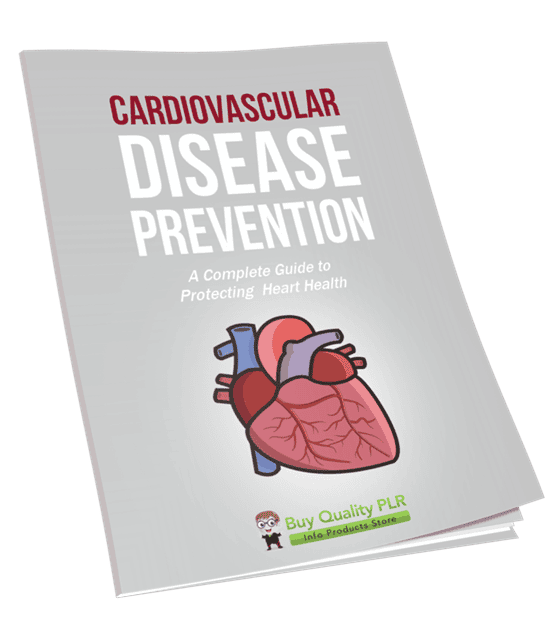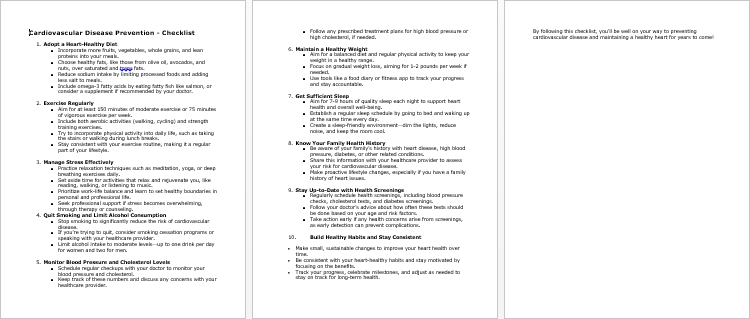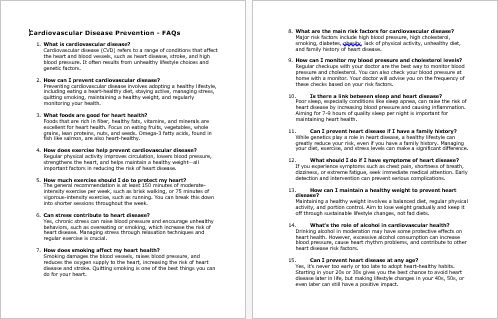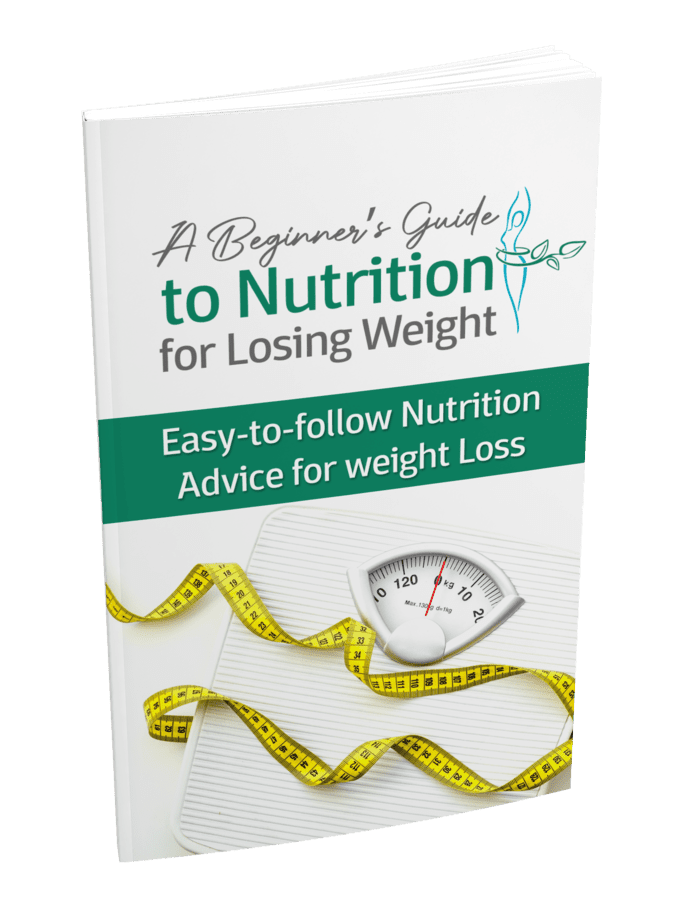
Cardiovascular Disease Prevention PLR Course 25k Words
in Health PLR , Health PLR eBooks , Heart Health PLR , PLR Checklists , PLR eBooks , PLR eCourses , PLR List Building Reports , Premium PLR , Premium PLR eBooks , Premium PLR Packages , Premium White Label Brandable PLR Coaching Courses , Private Label Rights ProductsChoose Your Desired Option(s)
has been added to your cart!
have been added to your cart!
#cardiovascularhealth #hearthealthplr #diseaseprevention #healthplrcourse #wellnesscontent #plrhealthcourse #preventheartdisease #healthyhearttips
Cardiovascular Disease Prevention PLR Course – A Complete Guide to Protecting Heart Health
Are you looking for a comprehensive and valuable PLR course on cardiovascular disease prevention? Look no further! The Cardiovascular Disease Prevention PLR Course is a complete resource designed to provide essential, step-by-step knowledge on how to understand, prevent, and manage cardiovascular disease. This 23,199-word course is perfect for health coaches, fitness trainers, wellness bloggers, and anyone in the healthcare industry who wants to educate their audience on the importance of heart health and disease prevention.
Course Overview: Cardiovascular Disease Prevention PLR Course
Course Title: Cardiovascular Disease Prevention
Total Word Count: 23,199 words
Content Included: 5 Detailed Modules + Checklist + FAQs + Salespage
Format: Complete PLR Course, Ready for Rebranding and Resale
This course offers clear and actionable content, focusing on the prevention and management of cardiovascular diseases. It’s designed to help individuals better understand the risks, causes, and preventative measures associated with heart disease. By the end of the course, your audience will have a practical understanding of how to take charge of their heart health, making informed decisions to reduce the risk of cardiovascular disease.
Presenting…
Cardiovascular Disease Prevention PLR Course 25k Words
What’s Included in the Cardiovascular Disease Prevention PLR Course?
5 Informative Modules on Heart Health and Disease Prevention
This course consists of 5 modules that will guide your audience through every aspect of cardiovascular health. Each module is packed with actionable advice, expert knowledge, and clear instructions to help participants live a heart-healthy lifestyle. Here’s a breakdown of what’s included:
Module 1: Understanding Cardiovascular Disease (CVD)
- What is Cardiovascular Disease?
Learn the basics of CVD and how it affects the heart and blood vessels. - Risk Factors for CVD
Identify risk factors such as high blood pressure, diabetes, smoking, obesity, and poor diet. - How Does CVD Develop?
Explore the biological process that leads to plaque build-up in arteries, restricting blood flow. - The Importance of Early Detection
Understand how early diagnosis can lead to better outcomes and ways to monitor your health.
Module 2: Nutrition and Heart Health
- Heart-Healthy Foods
Discover the foods that are most beneficial for heart health, including fruits, vegetables, and healthy fats. - The Role of Fiber in Heart Health
Learn how fiber helps lower cholesterol and reduce heart disease risk. - Reducing Saturated and Trans Fats
Explore which fats are harmful to the heart and how to replace them with healthier alternatives. - Sodium and Its Impact on Blood Pressure
Understand how salt contributes to high blood pressure and how to manage your intake.
Module 3: Exercise and Physical Activity
- Why Physical Activity Matters
Learn how exercise improves circulation and reduces the risk of heart disease. - How Much Exercise Do You Need?
Find out the recommended guidelines for exercise and how to incorporate physical activity into your routine. - Cardiovascular Exercises to Try
Explore various forms of exercise that are particularly beneficial for heart health, such as walking, jogging, and swimming. - Staying Consistent with Exercise
Get tips for making exercise a habit and staying motivated in the long term.
Module 4: Managing Stress for a Healthy Heart
- How Stress Affects the Heart
Discover the links between chronic stress and heart disease, including its effects on blood pressure and overall health. - Stress Management Techniques
Learn simple but effective methods for reducing stress, including meditation, yoga, and deep breathing. - The Importance of Sleep for Heart Health
Understand the role of quality sleep in reducing stress and supporting heart health. - Setting Healthy Boundaries
Learn how to manage your personal and professional life to avoid stress and improve well-being.
Module 5: Regular Checkups and Monitoring Your Health
- Importance of Regular Health Screenings
Understand why regular health checkups are crucial for heart health. - Monitoring Blood Pressure and Cholesterol
Learn how to track your blood pressure and cholesterol and what the numbers mean. - Know Your Family Health History
Discover the impact of genetics on heart disease and why knowing your family history is important. - When to Seek Professional Advice
Learn when to seek medical advice for heart health issues and what to expect during consultations.
Additional Materials Included in the Course Package:
- Cardiovascular Disease Prevention – Checklist (596 words)
A comprehensive checklist to summarize key actions and tips for preventing cardiovascular disease. Perfect for sharing with your audience as a downloadable PDF. - Cardiovascular Disease Prevention – FAQs (655 words)
A helpful FAQ section that answers common questions regarding cardiovascular disease prevention, providing quick and actionable advice. - Cardiovascular Disease Prevention – Salespage (817 words)
A professionally written sales page to help you market the course. It’s designed to convert visitors into customers and can be customized to fit your branding.
How to Use and Profit from the Cardiovascular Disease Prevention PLR Course
The Cardiovascular Disease Prevention PLR Course offers a range of monetization opportunities for health coaches, wellness bloggers, and fitness trainers looking to educate and empower their audience. Here’s how you can profit from this course:
- Sell the Course as a Digital Product:
Package the course as a standalone product on your website or through platforms like Udemy, Teachable, or Skillshare. Use the course as a lead magnet or part of a subscription-based membership site. - Create an Online Coaching Program:
Use the course as a foundation for your online coaching services, providing personalized guidance for individuals looking to improve their heart health. - Develop a Paid Membership Site:
Bundle the course with additional heart-health resources and create a paid membership site. Offer exclusive content and access to ongoing courses, webinars, or consultations. - Break It Up Into Smaller Products:
Use the individual modules and FAQs to create smaller, bite-sized products (e.g., eBooks, articles, or email series) that can be sold separately. - Offer Affiliate Marketing Opportunities:
Include affiliate links to recommended products related to cardiovascular health, such as supplements, fitness equipment, or heart-healthy foods, to earn commissions. - Host Workshops and Webinars:
Use the course as the content foundation for webinars or workshops that you can sell tickets for or offer as part of a larger educational program. - Create a Physical Product:
Convert the content into a printed guide or workbook that can be sold to clients or through your online store. - Repurpose Into Videos or Podcasts:
Convert the course material into engaging video content or podcasts to attract a broader audience and offer a new way for your audience to learn.
How to Make the Most of This PLR Course
With this Cardiovascular Disease Prevention PLR Course, you’re equipped with a comprehensive, well-structured resource that can be easily repurposed and customized.
- Personalize the Content: Add your voice to the content, integrate your branding, and adapt it to better suit your audience’s specific needs.
- Use for Lead Generation: Break the course into individual segments and use them as lead magnets to grow your email list.
- Offer Expert-Led Coaching or Support: Use the course as a foundation for providing one-on-one or group coaching services, offering personalized advice based on the course material.
Licensing and Usage Terms
With the Cardiovascular Disease Prevention PLR Course, you receive the right to:
- Sell the content as it is (with minor tweaks to make it “yours”).
- Break up the content into smaller reports for sale at $10-$20 each.
- Bundle the content with other related products for $47-$97.
- Set up a membership site or create a multiple-week eClass and charge for access.
- Convert the content into audio, video, and physical products for additional income.
- Use excerpts for blog posts, lead magnets, or free reports.
However, there are restrictions:
- You cannot pass the PLR rights on to your customers.
- You cannot offer 100% commission to affiliates selling this course.
- You cannot give the complete materials away for free (except in excerpts).
Start Offering Heart Health Education Today!
Don’t miss out on this opportunity to offer your audience a life-changing course on cardiovascular disease prevention. With the Cardiovascular Disease Prevention PLR Course, you can educate your audience while generating a sustainable income. Customize, rebrand, and market it your way – all while helping people improve their heart health. Get started today!
has been added to your cart!
have been added to your cart!
Here A Sample of Cardiovascular Disease Prevention PLR Course
Welcome to the “Cardiovascular Disease Prevention” course! In this course, we’ll break down essential steps to help you understand, prevent, and manage cardiovascular disease. Let’s dive right in with our easy-to-follow, step-by-step modules. Ready to learn? Let’s go!
Module 1: Understanding Cardiovascular Disease (CVD)
In this module, we’ll explore what cardiovascular disease is, its causes, and why it’s so important to prevent it.
Step 1: What is Cardiovascular Disease?
Cardiovascular disease (CVD) encompasses a broad spectrum of conditions that affect the heart and blood vessels. It is a major health issue worldwide, causing millions of deaths annually. Understanding the nature of cardiovascular disease is crucial for both prevention and treatment. In this section, we’ll provide a comprehensive definition, explain the various forms of cardiovascular disease, and discuss how it impacts global health.
1.1: Defining Cardiovascular Disease
Cardiovascular disease refers to a group of disorders that impact the heart and blood vessels, including:
- Coronary artery disease (CAD): This condition occurs when the arteries supplying blood to the heart muscle become narrowed or blocked due to plaque buildup. CAD can lead to heart attacks (myocardial infarctions) and is the most common type of cardiovascular disease.
- Heart failure: Also known as congestive heart failure, this condition occurs when the heart is unable to pump blood effectively, leading to a build-up of fluid in the lungs and other parts of the body.
- Stroke: A stroke occurs when the blood supply to a part of the brain is interrupted, either by a blockage (ischemic stroke) or a burst blood vessel (hemorrhagic stroke). The brain cells deprived of oxygen can result in long-term disabilities or death.
- Peripheral artery disease (PAD): PAD occurs when the blood vessels outside of the heart and brain become narrowed or blocked, usually affecting the legs. This can cause pain, numbness, and increase the risk of infection or amputation.
- Arrhythmias: Arrhythmias are abnormal heart rhythms, which can range from harmless to life-threatening. Examples include atrial fibrillation and ventricular fibrillation.
- Congenital heart defects: These are structural heart abnormalities present at birth, which may or may not lead to complications later in life.
These conditions are linked by the fact that they involve the heart or blood vessels. While some cardiovascular conditions are genetic or congenital, many are the result of lifestyle factors, including diet, exercise, and stress management.
1.2: How Cardiovascular Disease Develops
Cardiovascular disease develops over time and often begins with damage to the blood vessels. Several factors contribute to this damage, such as:
- Atherosclerosis: A condition where the walls of the arteries become thickened and narrowed due to the accumulation of fatty deposits (plaque). Over time, this can restrict blood flow, increase blood pressure, and increase the risk of heart attacks and strokes.
- Hypertension (High Blood Pressure): Chronic high blood pressure puts strain on the heart and blood vessels, making them less flexible and more prone to damage. High blood pressure often goes unnoticed because it has no symptoms until it leads to a serious event such as a heart attack or stroke.
- High Cholesterol: Elevated cholesterol levels, particularly low-density lipoprotein (LDL) cholesterol (often referred to as “bad” cholesterol), can contribute to the buildup of plaque in the arteries, leading to blockages.
- Smoking and Substance Use: Smoking accelerates the process of atherosclerosis and increases the risk of clot formation, while certain drugs, such as cocaine, can lead to severe heart attacks or arrhythmias.
- Diabetes: High blood sugar from uncontrolled diabetes can damage the blood vessels, leading to an increased risk of CVD, as well as complications such as kidney disease or neuropathy.
- Obesity and Physical Inactivity: Being overweight or obese increases the risk of heart disease and stroke, while a lack of physical activity contributes to other risk factors such as high cholesterol and high blood pressure.
Understanding these mechanisms is crucial for preventing cardiovascular disease. Lifestyle modifications, such as adopting a balanced diet, exercising regularly, and avoiding smoking, can help prevent these risk factors from leading to more severe complications.
1.3: Impact of Cardiovascular Disease on Health
Cardiovascular disease is a global health burden, with millions affected worldwide. The consequences of CVD are far-reaching, impacting not only physical health but also mental well-being and overall quality of life. Here’s a breakdown of how cardiovascular disease affects individuals and societies:
1.3.1: Physical Health Impact
- Heart Attacks and Strokes: These events can result in permanent damage to the heart or brain, leading to reduced functionality and, in many cases, lifelong disabilities. After a heart attack, patients may experience chronic fatigue, shortness of breath, and reduced physical capacity. Similarly, stroke survivors may experience speech impairments, paralysis, and cognitive decline.
- Reduced Quality of Life: Individuals with cardiovascular disease often struggle with daily tasks due to pain, weakness, or fatigue. Simple activities such as climbing stairs, walking, or lifting objects can become challenging.
- Increased Mortality: Cardiovascular disease is the leading cause of death worldwide, responsible for an estimated 17.9 million deaths annually. Many of these deaths could have been prevented through proper lifestyle changes, early diagnosis, and treatment.
1.3.2: Mental Health Impact
- Stress and Anxiety: A diagnosis of cardiovascular disease can trigger significant mental health challenges, including stress, anxiety, and depression. The fear of heart attacks or strokes, along with the physical limitations imposed by the disease, can negatively affect mental well-being.
- Cognitive Decline: Studies show that individuals with cardiovascular disease are at an increased risk of developing cognitive impairment or dementia. Poor circulation to the brain, caused by blocked arteries, can impair memory and cognitive function.
1.3.3: Societal and Economic Impact
- Healthcare Costs: Cardiovascular disease places a heavy burden on healthcare systems worldwide. The costs of hospitalization, treatments, medications, and rehabilitation add up quickly. The Global Burden of Disease Study estimates that the total economic burden of CVD is in the trillions of dollars annually.
- Loss of Productivity: Cardiovascular disease often results in lost workdays due to illness or recovery. Many individuals with severe CVD become unable to continue working, which affects their income and economic stability. This, in turn, places a burden on their families and communities.
- Global Health Disparities: Low- and middle-income countries bear a disproportionate burden of cardiovascular disease, partly due to limited access to healthcare, inadequate nutrition, and higher rates of smoking and physical inactivity. These regions often experience higher mortality rates from CVD compared to high-income countries, where early detection and treatment options are more widely available.
1.4: Conclusion
Understanding what cardiovascular disease is, how it develops, and its far-reaching impact on individuals and societies is the first step toward prevention. The good news is that most cardiovascular conditions are preventable or manageable through lifestyle changes, early diagnosis, and effective treatment. In the following steps of this course, we will dive deeper into how you can protect your heart, reduce risk factors, and adopt healthier habits to ensure long-term cardiovascular health.
By understanding the nature of cardiovascular disease and its consequences, you are better equipped to make informed decisions that can improve your health and well-being. Remember, it’s never too early or too late to start making heart-healthy choices!
Step 2: Risk Factors for Cardiovascular Disease (CVD)
Cardiovascular disease (CVD) is influenced by a range of risk factors. Understanding these factors is essential to preventing or managing heart-related health conditions. In this step, we will explore the most common and significant risk factors for CVD, such as high blood pressure, diabetes, smoking, obesity, and poor diet. We’ll break down how each of these factors contributes to heart disease and how they can be managed or mitigated.
2.1: High Blood Pressure (Hypertension)
High blood pressure, also known as hypertension, is one of the most significant and common risk factors for cardiovascular disease. It often develops silently, meaning there are usually no obvious symptoms until significant damage has been done. When blood pressure remains high over time, it puts extra strain on the heart and blood vessels, leading to various cardiovascular problems.
How Hypertension Affects Heart Health:
- Damage to the Arteries: Chronic high blood pressure can lead to the thickening of artery walls, making them stiff and less flexible. This condition is called arteriosclerosis and can result in blocked arteries, which limits blood flow to the heart and other vital organs.
- Heart Enlargement: The heart has to work harder to pump blood against the increased resistance from narrowed or stiffened arteries. Over time, this extra strain can lead to heart enlargement, a condition known as hypertrophy, which increases the risk of heart failure.
- Increased Risk of Heart Attack and Stroke: High blood pressure accelerates the process of plaque buildup in the arteries (atherosclerosis), which can result in heart attacks, strokes, or even kidney damage. The higher the blood pressure, the greater the strain on the cardiovascular system.
Managing High Blood Pressure:
- Regular Monitoring: It is essential to check blood pressure regularly, especially for those at risk, to identify hypertension early.
- Lifestyle Changes: Maintaining a healthy weight, engaging in regular physical activity, reducing sodium intake, and consuming alcohol in moderation can help manage blood pressure levels.
- Medications: In some cases, medication is necessary to keep blood pressure in a healthy range.
2.2: Diabetes
Diabetes, particularly type 2 diabetes, is a condition where the body is either unable to produce enough insulin or cannot use it effectively. Insulin is a hormone that regulates blood sugar levels. When diabetes is uncontrolled, high blood sugar levels can damage the blood vessels and organs over time, significantly increasing the risk of cardiovascular disease.
How Diabetes Affects Heart Health:
- Blood Vessel Damage: High blood sugar levels can damage the lining of the blood vessels, making them more prone to the buildup of fatty deposits or plaque. This leads to the narrowing and hardening of arteries (atherosclerosis), which increases the risk of heart disease, heart attacks, and stroke.
- Increased Blood Pressure: Diabetes is closely linked to high blood pressure, as high glucose levels can cause kidney damage, leading to fluid retention and elevated blood pressure, further straining the heart and blood vessels.
- Increased Risk of Heart Disease: People with diabetes are two to four times more likely to develop cardiovascular disease compared to those without diabetes. In fact, cardiovascular disease is the leading cause of death in individuals with diabetes.
Managing Diabetes to Protect Heart Health:
- Blood Sugar Control: Proper management of blood sugar through diet, exercise, and medications is crucial in reducing the risk of cardiovascular complications.
- Healthy Lifestyle Choices: A balanced diet that controls blood sugar levels, regular exercise, and stress management can significantly improve cardiovascular health.
- Regular Health Checkups: Regular visits to a healthcare provider for blood sugar and cholesterol monitoring, along with blood pressure checks, are important for managing diabetes and heart health simultaneously.
2.3: Smoking
Smoking is a leading cause of preventable diseases worldwide, and its detrimental effects on cardiovascular health are well-documented. Chemicals in tobacco smoke harm the heart and blood vessels, leading to numerous heart problems.
How Smoking Affects Heart Health:
- Damage to Blood Vessels: Smoking causes the blood vessels to constrict, reducing blood flow to the heart and other organs. This increases blood pressure and heart rate, making the heart work harder.
- Increased Risk of Atherosclerosis: The toxic chemicals in cigarette smoke contribute to the formation of plaque in the arteries. Over time, this buildup narrows and hardens the arteries, a condition known as atherosclerosis, which can result in heart attacks or strokes.
- Increased Risk of Clot Formation: Smoking increases the likelihood of blood clot formation. This is dangerous because a clot can block blood flow to the heart, causing a heart attack, or to the brain, resulting in a stroke.
- Impaired Oxygen Supply: Smoking reduces the amount of oxygen in the blood, which means less oxygen is available for the heart and other vital organs. This can contribute to fatigue, shortness of breath, and ultimately heart failure.
How to Quit Smoking:
- Behavioral Support and Therapy: Nicotine replacement therapies (NRT), counseling, and support groups can help individuals quit smoking and manage withdrawal symptoms.
- Medications: There are several prescription medications that can help reduce cravings and ease the quitting process.
- Gradual Reduction: For some individuals, a gradual reduction in smoking may be an effective strategy before completely quitting.
2.4: Obesity
Obesity is a significant risk factor for a range of cardiovascular diseases. Obesity is defined as having an excessive amount of body fat, which places extra strain on the heart and increases the likelihood of developing other risk factors such as high blood pressure, diabetes, and high cholesterol.
How Obesity Affects Heart Health:
- Increased Heart Workload: Carrying excess weight increases the strain on the heart, causing it to work harder to pump blood throughout the body. This can lead to heart failure, arrhythmias, and other complications.
- Increased Cholesterol and Blood Pressure: Obesity is closely linked to higher levels of LDL (bad cholesterol) and triglycerides, as well as elevated blood pressure. These contribute to the narrowing of the arteries, increasing the risk of atherosclerosis and other cardiovascular diseases.
- Insulin Resistance and Diabetes: Obesity contributes to insulin resistance, which is the precursor to type 2 diabetes. This, in turn, increases the risk of cardiovascular disease.
- Increased Inflammation: Excess fat, particularly abdominal fat, produces inflammatory substances that increase the risk of cardiovascular disease by promoting the buildup of plaque in the arteries.
Managing Obesity for Heart Health:
- Balanced Diet: A diet rich in fruits, vegetables, whole grains, lean proteins, and healthy fats can promote weight loss and support heart health.
- Regular Exercise: Engaging in regular physical activity helps burn excess fat, improve cardiovascular fitness, and reduce risk factors such as high blood pressure and cholesterol.
- Behavioral Changes: Developing healthy eating habits, practicing portion control, and focusing on long-term weight management are essential for reducing obesity-related risks.
2.5: Poor Diet
A poor diet, which is high in processed foods, saturated fats, sodium, and added sugars, is a leading cause of cardiovascular disease. An unhealthy diet contributes to several other risk factors, including obesity, high blood pressure, high cholesterol, and diabetes.
How Poor Diet Affects Heart Health:
- High Cholesterol: Diets rich in unhealthy fats, such as trans fats and saturated fats, can raise levels of LDL cholesterol (the “bad” cholesterol) in the blood, leading to plaque buildup in the arteries (atherosclerosis).
- High Blood Pressure: Diets high in salt (sodium) can lead to high blood pressure. Sodium causes the body to retain water, which increases the volume of blood and puts extra pressure on the blood vessels.
- Weight Gain and Obesity: A diet that is high in calories, unhealthy fats, and refined sugars contributes to weight gain and obesity, both of which are risk factors for cardiovascular disease.
- Inflammation: A poor diet, particularly one rich in processed foods, refined sugars, and unhealthy fats, can trigger inflammation in the body, which promotes heart disease and other chronic conditions.
Healthy Diet for Heart Health:
- Increase Fruit and Vegetable Intake: A diet rich in fruits and vegetables provides essential vitamins, minerals, and fiber that promote heart health.
- Choose Healthy Fats: Opt for unsaturated fats found in foods like avocados, nuts, and olive oil, and limit consumption of trans fats and saturated fats.
- Limit Sodium and Sugar: Reducing salt and sugar intake is crucial for maintaining healthy blood pressure and preventing excessive weight gain.
- Moderate Alcohol Intake: Excessive alcohol consumption can raise blood pressure and contribute to heart disease. Moderation is key.
Conclusion
Understanding these key risk factors — high blood pressure, diabetes, smoking, obesity, and poor diet — is essential for preventing cardiovascular disease. By managing these factors, individuals can significantly reduce their risk of developing heart-related conditions and improve their overall quality of life. In the next step, we will discuss strategies for effectively preventing CVD and reducing your risk through lifestyle changes, screenings, and proper medical care.
Step 3: How Does Cardiovascular Disease (CVD) Develop?
Understanding how cardiovascular disease (CVD) develops is crucial to preventing it. In this step, we’ll dive into the process of plaque buildup in the arteries, which is at the heart of most cardiovascular conditions. This buildup can restrict blood flow, damage the blood vessels, and lead to serious health problems like heart attacks and strokes. By the end of this section, you will have a clear understanding of the chain of events that lead to cardiovascular disease and how it impacts heart health.
3.1: What is Atherosclerosis?
Atherosclerosis is the primary condition through which cardiovascular disease develops. It’s a process in which the walls of the arteries become thickened and hardened due to the accumulation of fatty substances, cholesterol, and other materials. This process gradually narrows the arteries, reducing blood flow to the heart and other organs.
How Atherosclerosis Develops:
- Initial Damage: The process often begins with damage to the endothelium, the thin layer of cells that line the inside of the blood vessels. This damage can be caused by factors such as high blood pressure, smoking, high cholesterol, or diabetes. When the endothelium is damaged, it makes it easier for harmful substances like cholesterol to stick to the artery walls.
- Plaque Formation: Over time, the damaged area of the artery wall attracts a combination of low-density lipoprotein (LDL) cholesterol, white blood cells, and other substances. This collection forms a plaque, which thickens and hardens the artery walls. The plaque may grow over time, narrowing the artery and making it more difficult for blood to flow freely.
- Fatty Streaks and Foam Cells: In the early stages of atherosclerosis, small fatty streaks may form in the arterial walls. These streaks consist mainly of cholesterol and are the first visible sign of atherosclerosis. Over time, these fatty streaks may develop into larger plaques. When macrophages (a type of white blood cell) consume LDL cholesterol, they become foam cells, which contribute to the plaque buildup.
3.2: The Role of Cholesterol in Plaque Buildup
Cholesterol is a fatty substance that is found in every cell in your body. It plays important roles in making hormones, building cell membranes, and producing vitamin D. However, cholesterol can also be a major factor in the development of CVD, particularly when it’s in high concentrations.
Types of Cholesterol:
- Low-Density Lipoprotein (LDL) Cholesterol: Often referred to as “bad” cholesterol, LDL is the primary culprit in plaque buildup. When there is too much LDL cholesterol in the blood, it can infiltrate the walls of the arteries and form plaques. This narrows the arteries and makes it difficult for blood to flow to vital organs, including the heart.
- High-Density Lipoprotein (HDL) Cholesterol: Known as “good” cholesterol, HDL helps remove excess cholesterol from the bloodstream by transporting it to the liver, where it is processed and removed from the body. A higher level of HDL can help protect against atherosclerosis.
How Cholesterol Contributes to CVD:
- LDL Cholesterol Accumulation: High levels of LDL cholesterol cause it to deposit in the walls of the arteries, particularly in areas where the endothelial cells are damaged. This triggers an inflammatory response and contributes to the thickening and hardening of the arteries, leading to plaque buildup.
- Plaque Rupture: Over time, the plaque may grow large enough to cause the artery to become brittle. This can lead to the rupture of the plaque, which can cause a blood clot to form at the site. If the clot blocks the flow of blood to the heart or brain, it can result in a heart attack or stroke.
3.3: The Role of Inflammation in CVD Development
Inflammation is a natural response of the body to injury or infection. However, chronic inflammation plays a significant role in the development and progression of cardiovascular disease. In fact, atherosclerosis is often described as a chronic inflammatory process.
How Inflammation Contributes to Plaque Formation:
- Initial Inflammatory Response: When the artery walls are damaged due to factors like high blood pressure, smoking, or high cholesterol, the body’s immune system sends white blood cells to the site of injury. These immune cells attempt to repair the damage, but they can also cause additional damage and inflammation, which worsens the condition.
- Worsening Plaque: As the immune cells continue to attack the damaged artery wall, they create a cycle of inflammation that encourages the accumulation of more cholesterol and other substances, leading to the formation of larger plaques. This process further narrows the arteries and makes them stiffer.
- Plaque Instability: Inflammation can also make plaques unstable, causing them to rupture. When a plaque ruptures, it can lead to the formation of a blood clot that can block blood flow to vital organs like the heart and brain, resulting in heart attacks or strokes.
Controlling Inflammation:
- Anti-Inflammatory Lifestyle: Adopting an anti-inflammatory lifestyle can help prevent and manage atherosclerosis. This includes eating an anti-inflammatory diet rich in fruits, vegetables, and whole grains, engaging in regular physical activity, and reducing stress. Additionally, medications like statins can help reduce inflammation and lower cholesterol levels.
3.4: The Impact of Restricted Blood Flow on Heart Health
As plaque builds up in the arteries, it restricts blood flow to the heart and other vital organs. This reduced blood flow deprives the heart of oxygen and essential nutrients, which can lead to serious cardiovascular problems.
How Restricted Blood Flow Affects the Heart:
- Angina: Angina is chest pain or discomfort that occurs when the heart muscle doesn’t get enough oxygen-rich blood. This can happen when the coronary arteries, which supply blood to the heart, become narrowed or blocked by plaque. Angina is often triggered by physical activity or stress.
- Heart Attack (Myocardial Infarction): If a plaque ruptures and a blood clot forms, it can block a coronary artery completely, causing a heart attack. This means the heart muscle is no longer receiving oxygen-rich blood, which can cause permanent damage to the heart muscle.
- Heart Failure: Over time, restricted blood flow due to atherosclerosis can weaken the heart muscle, making it less effective at pumping blood. This can lead to heart failure, a condition in which the heart is unable to pump enough blood to meet the body’s needs.
The Role of Blood Flow in CVD Prevention:
- Blood Flow Restoration: Procedures like angioplasty, stent placement, or coronary artery bypass surgery may be necessary to restore blood flow in individuals with severe plaque buildup. These treatments can help prevent heart attacks and improve heart function.
3.5: Other Contributing Factors to CVD Development
While atherosclerosis is the main pathway for the development of cardiovascular disease, other factors can contribute to the process as well. These include:
- High Blood Pressure: Hypertension causes additional strain on the arteries, accelerating the process of plaque buildup and contributing to the hardening of the arteries.
- Diabetes: High blood sugar levels damage the blood vessels, making it easier for cholesterol and other substances to accumulate and form plaques.
- Lifestyle Factors: Poor diet, lack of physical activity, smoking, and excessive alcohol consumption all contribute to the development of atherosclerosis and increase the risk of cardiovascular disease.
Conclusion
Understanding how cardiovascular disease develops is key to preventing it. The process of plaque buildup in the arteries, combined with inflammation and restricted blood flow, is at the core of most heart-related conditions. By addressing the factors that contribute to atherosclerosis—such as high cholesterol, high blood pressure, diabetes, smoking, and poor diet—you can significantly reduce your risk of developing cardiovascular disease. In the next step, we will explore preventive measures and lifestyle changes that can help you protect your heart health and reduce the risk of CVD.
We’re also giving these extra bonuses
Cardiovascular Disease Prevention – Checklist

Cardiovascular Disease Prevention – FAQs
Cardiovascular Disease Prevention – Salespage Content

Package Details:
Word Count: 23 199 Words
Number of Pages: 93
Cardiovascular Disease Prevention – Bonus Content
Checklist
Word Count: 596 words
FAQs
Word Count: 655 words
Salespage Content
Word Count: 817 words
Total Word Count: 25 267 Words
Your PLR License Terms
PERMISSIONS: What Can You Do With These Materials?
Sell the content basically as it is (with some minor tweaks to make it “yours”).
If you are going to claim copyright to anything created with this content, then you must substantially change at 75% of the content to distinguish yourself from other licensees.
Break up the content into small portions to sell as individual reports for $10-$20 each.
Bundle the content with other existing content to create larger products for $47-$97 each.
Setup your own membership site with the content and generate monthly residual payments!
Take the content and convert it into a multiple-week “eclass” that you charge $297-$497 to access!
Use the content to create a “physical” product that you sell for premium prices!
Convert it to audios, videos, membership site content and more.
Excerpt and / or edit portions of the content to give away for free as blog posts, reports, etc. to use as lead magnets, incentives and more!
Create your own original product from it, set it up at a site and “flip” the site for megabucks!
RESTRICTIONS: What Can’t You Do With These Materials?
To protect the value of these products, you may not pass on the rights to your customers. This means that your customers may not have PLR rights or reprint / resell rights passed on to them.
You may not pass on any kind of licensing (PLR, reprint / resell, etc.) to ANY offer created from ANY PORTION OF this content that would allow additional people to sell or give away any portion of the content contained in this package.
You may not offer 100% commission to affiliates selling your version / copy of this product. The maximum affiliate commission you may pay out for offers created that include parts of this content is 75%.
You are not permitted to give the complete materials away in their current state for free – they must be sold. They must be excerpted and / or edited to be given away, unless otherwise noted. Example: You ARE permitted to excerpt portions of content for blog posts, lead magnets, etc.
You may not add this content to any part of an existing customer order that would not require them to make an additional purchase. (IE You cannot add it to a package, membership site, etc. that customers have ALREADY paid for.)
Deprecated: Function post_permalink is deprecated since version 4.4.0! Use get_permalink() instead. in /home/buyqualityplr/public_html/wp-includes/functions.php on line 6121
Share Now!












